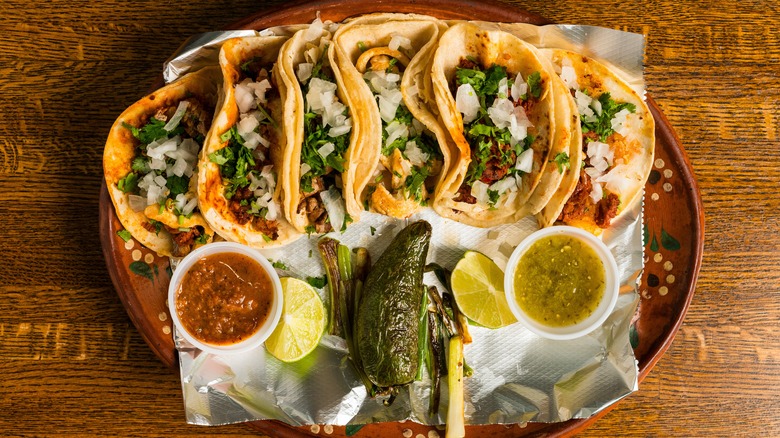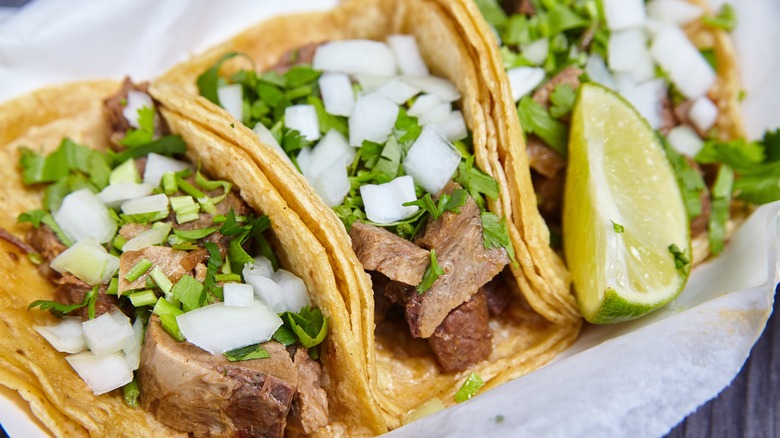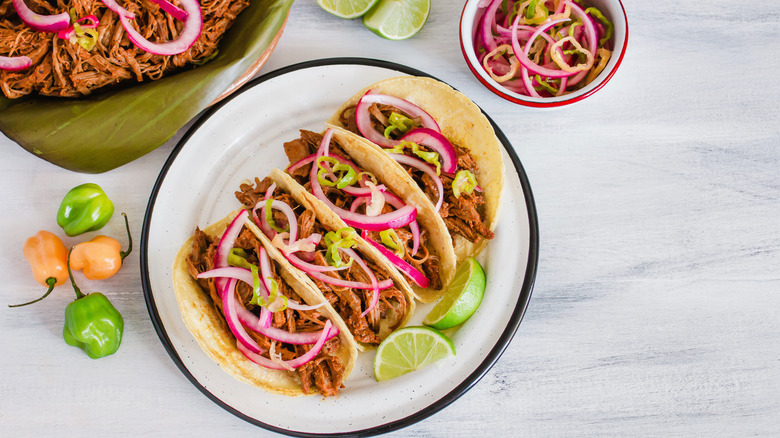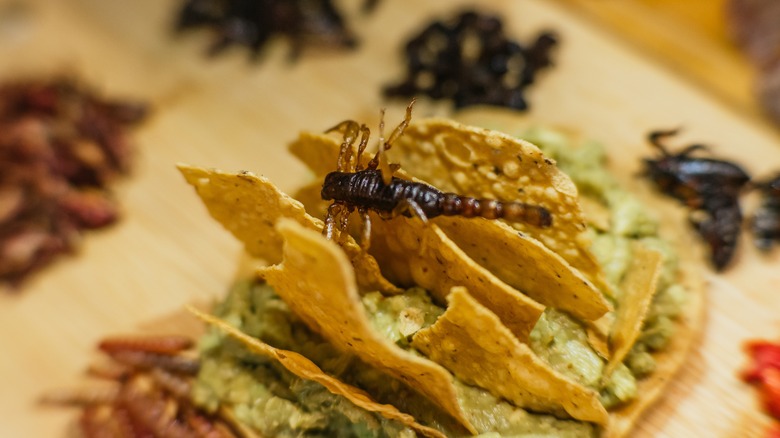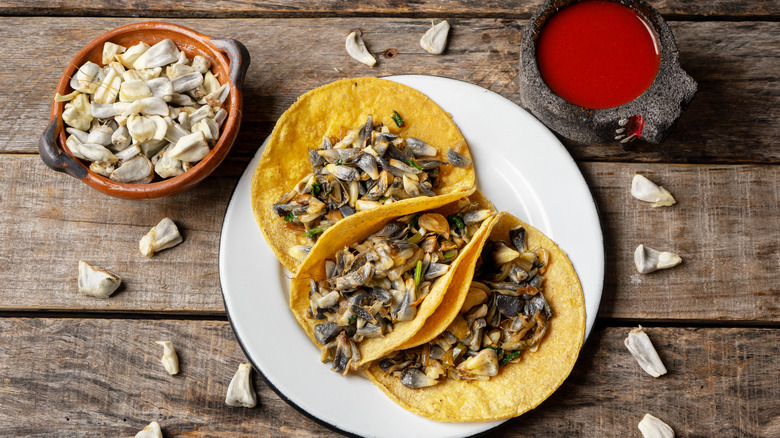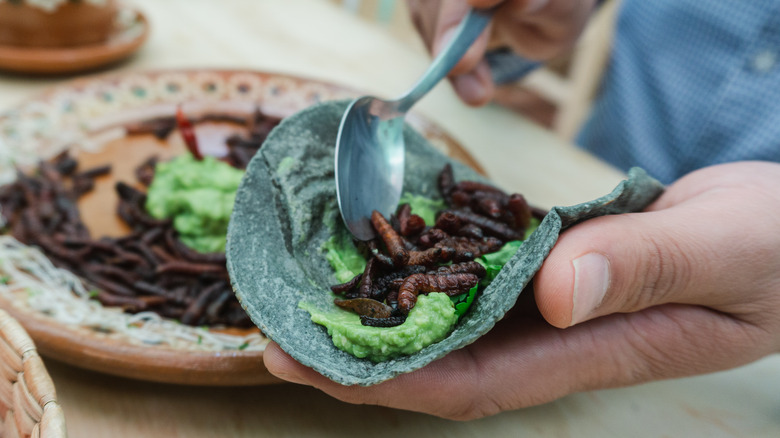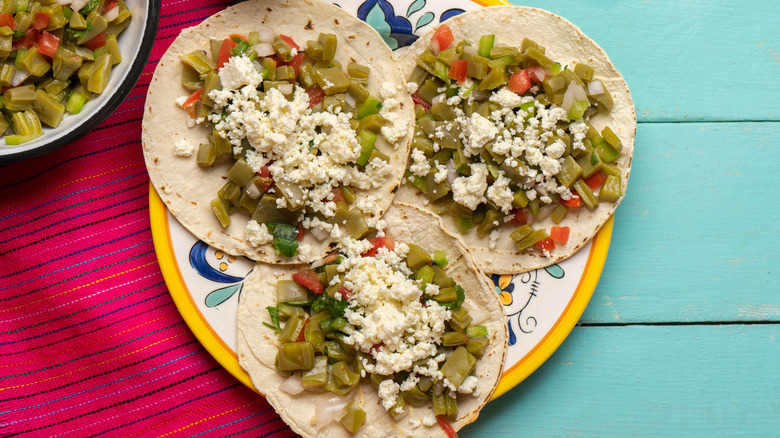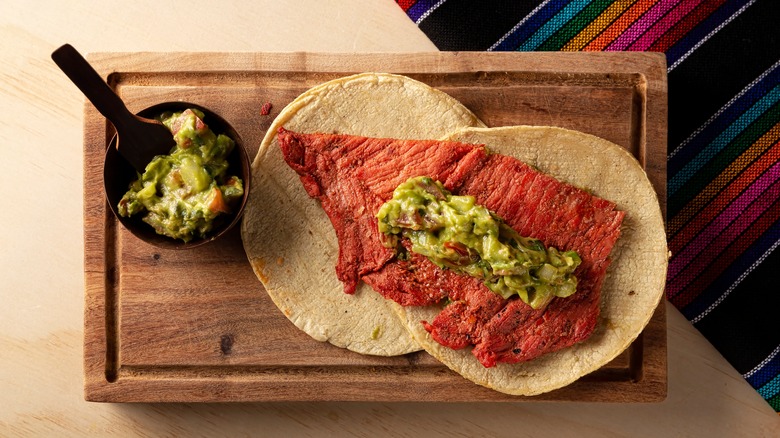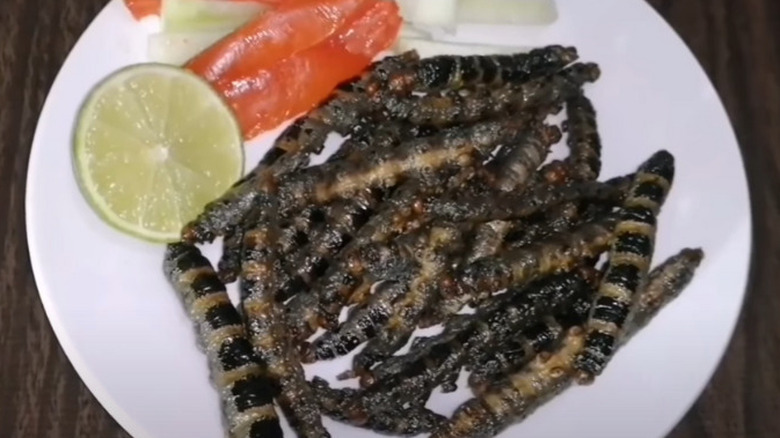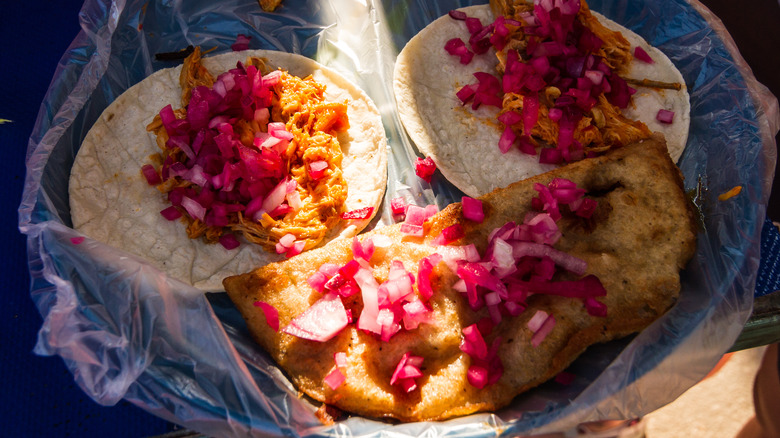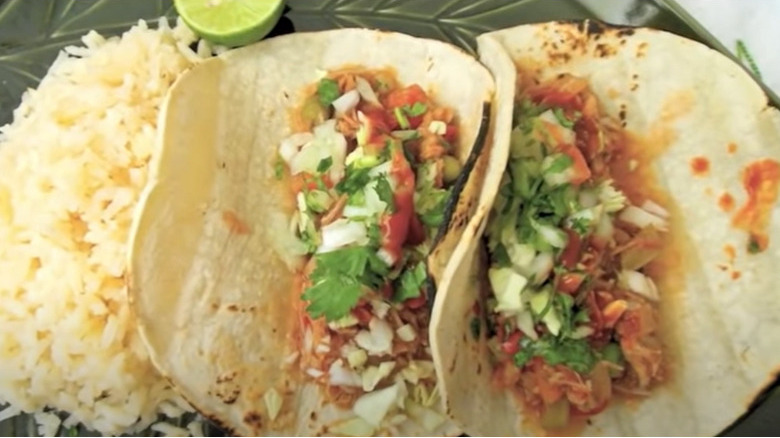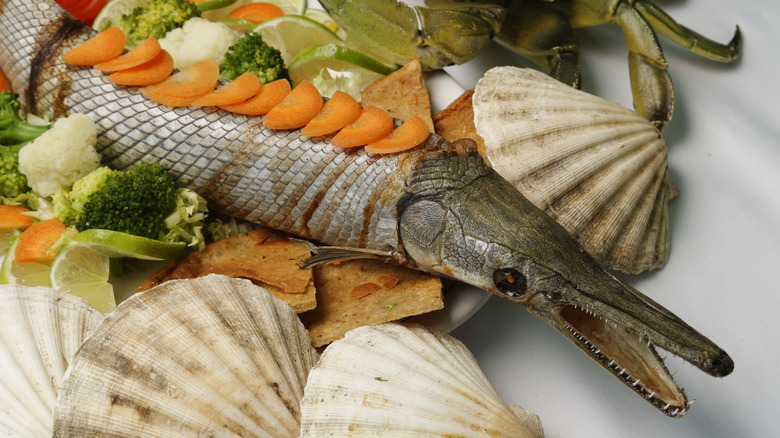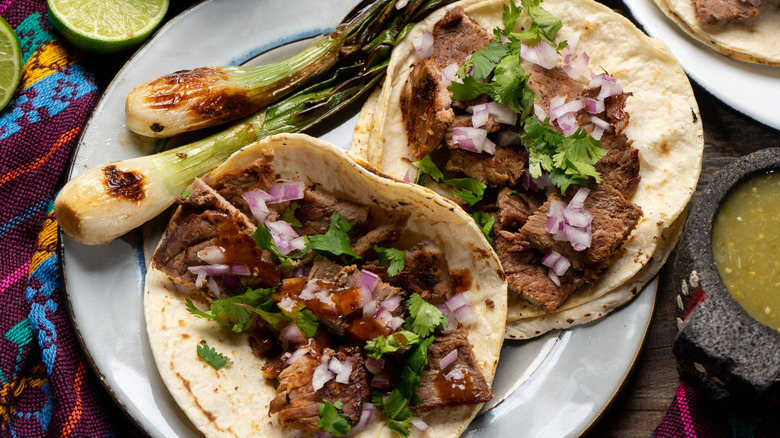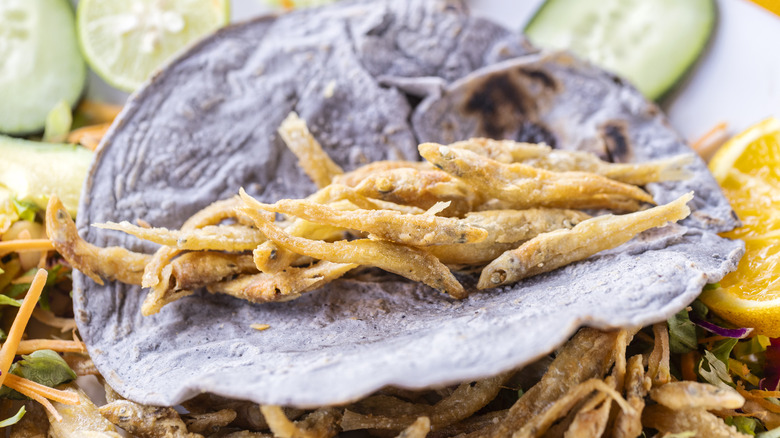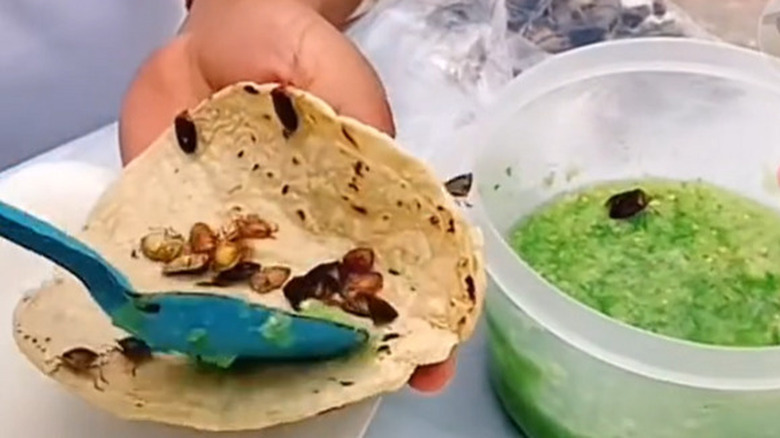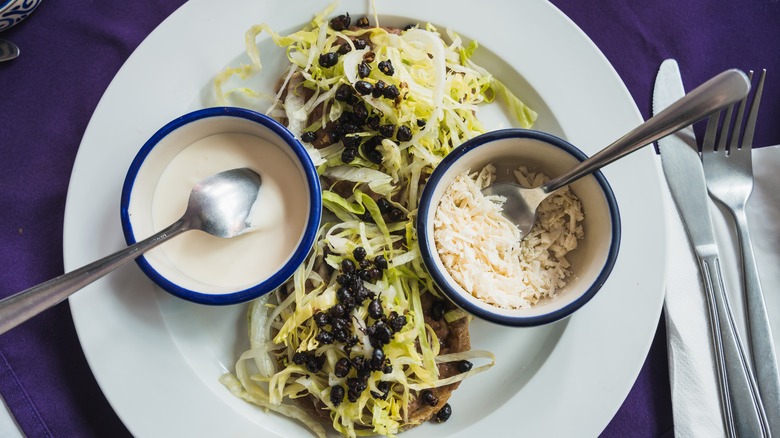15 Types Of Tacos You Need To Try At Least Once
Everyone loves Mexican food, and the humble taco is the star of this globally celebrated cuisine. From Taco Tuesday to taco trucks to taco bars, they're always a hit. There is no one right way to make a taco: They come in all shapes and sizes, from crunchy, hard-shell, American-style tacos to soft corn tortillas filled with savory meats to crispy, deep-fried taquitos. Moreover, there are more types of tacos than you might expect. Most people are familiar with classic taco fillings like carne asada and carne al pastor, and the recent popularity of barbacoa and birria tacos have given diners new ways to enjoy their favorite food. But this is still only the tip of the iceberg as far as taco fillings are considered.
Let's take a trip through Mexico and explore some of the most unique tacos you need to try. Some of these tacos are made from regional ingredients and are local delicacies, while others are made from parts of animals that don't get much attention and are usually thrown out. A few of these tacos are made with things you might be surprised to find sizzling in a skillet. You may not love all of these tacos, but they're definitely all worth knowing.
1. Cow tongue - Mexico City
Tacos made with cow tongue, or tacos de lengua de res, are popular in Mexico City. For some, eating cow tongue might seem unappealing, but beef tongue has been consumed by various cultures for a long time. It is a nourishing organ meat rich in iron, zinc, and vitamin B-12.
The key to cooking cow tongue is getting the texture right, and the taquerías of Mexico are full of experts. They start by boiling the tongue to soften it and remove the outer layer. Then, they braise the meat with spices like garlic, cloves, and black pepper to infuse it with rich flavor. Cow tongue has a lot of fat, and when that fat is slowly braised, it breaks down, giving the meat that melt-in-your-mouth texture. The tongue itself has a mild beefy flavor and creamy texture that contrasts well against the tangy chopped onion and cilantro that typically top these tacos. A creamy salsa verde with a slight jalapeño kick is another excellent accompaniment.
2. Cochinita pibil - Yucatan
Cochinita pibil is a popular taco filling in the Yucatan. Cochinita translates to "little pig," and "pibil," which comes from the Mayan language, means "cooking underground." However, these days, most taquerías forgo the underground oven and opt to slow-cook the meat in a deep pot on the stove. Cochinita pibil is made from the leg and thigh of a young pig; the meat is cooked for hours until it is tender. Tacos with cochinita pibil are often served with pickled red onions.
Some diners think of cochinita pibil as a Mexican version of pulled pork, but with a whole new flavor. This unique taste comes from achiote paste. Achiote paste is popular in Mexican cuisine for its flavor and bright orangish-red color. Surprisingly, the paste isn't made with colorful chiles, but with annatto seeds mashed with oregano, cloves, cumin, black pepper, and bitter orange. This paste isn't just tasty, either — it also tenderizes the meat, which makes for excellent tacos. While they're originally from the Yucatan, you can find cochinita pibil tacos throughout the country.
3. Scorpions - Durango
Scorpion tacos are a hit in the northern state of Durango, where the stinging creepy-crawlies are everywhere. These dangerous little creatures may not seem like the ideal taco filling, but they're actually quite tasty. Once you get over the shock factor of scorpion tacos, you might be surprised by how much you enjoy this fried arachnid's flavor and texture.
Expert taqueros in Durango have learned how to prepare scorpions to make them safe to eat. First, the live scorpions are caught and placed in a jar of alcohol. Then, before cooking, the stinger is removed so nobody gets hurt. Next, they are fried directly on the skillet with a bit of oil or given a quick dip in flour before hitting the pan. The outer shell and the oil turn the scorpions into crunchy taco filling that some have commented tastes like French fries. Scorpion tacos might be a little hard to swallow, but you might just find you like them — plus, it's worth the tale you get to tell about eating one of the most dangerous arachnids in the world.
In Durango, scorpions aren't just in tacos; you can find them in mezcal liquor, too. The scorpion is more for decoration than anything else, but some do eat it after the liquor is finished.
4. Huitlacoche - Mexico State
Huitlacoche, pronounced "weet-luh-kow-chay," is an edible fungus that grows on corn and is used in many Mexican dishes, including tacos. The fungus goes by many names, including sweet corn smut, corn mushrooms, and, in an effort to make it more appealing to newbies, Mexican truffles. It grows during Mexico's rainy season, which starts in May and goes through September. While this blueish-blackish fungus hasn't caught on among American diners as other Mexican foods have, it should get more attention. This one-of-a-kind taco filling has a unique taste and is a versatile ingredient.
Like mushrooms, huitlacoche has an earthy umami flavor; in fact, it's often paired with mushrooms, resulting in a hearty vegetarian taco option. Huitlacoche can be eaten raw, but most taquerías give it a light sauté to bring out its flavor. If it's overcooked or cooked with too much oil, the kernels become soggy and lose their texture. Avoiding this is fairly easy, however, especially for experienced chefs. Huitlacoche tacos are usually served with epazote, a traditional herb with a pungent, zesty taste that suits the unique fungus perfectly.
5. Maguey worms - Jalisco
The state of Jalisco is known for tequila, Tapatío hot sauce, and being the birthplace of birria. While birria tacos get a lot of attention, Jalisco has another taco filling making headlines: maguey worms.
While you may never have heard of maguey worms, you might have seen them in bottles of tequila. These little worms can be either red or white and are found in agave (maguey in Spanish) plants. The agave plant is used to make tequila and mezcal, hence the worm's presence in bottles of alcohol. These worms, called chinicuiles in Spanish, are actually in the caterpillar family. They live in the roots of the agave and have been eaten since the days of the Aztecs. They're popular in tacos slathered with guacamole or fried as a salty, crunchy snack. In some regions, they're even dried and ground with chiles and salt to be used as a seasoning.
6. Nopales - Morelos
Cactus is a surprisingly edible plant with round, colorful fruits called prickly pears and flat green nopales. Nopales are the paddle of the cactus plant. They have an enjoyably mild taste of their own, but when spiced up, they make great taco filling.
Tacos de nopales are perfect for vegetarians and meat eaters alike. Cooked nopales resemble overcooked green peppers in texture, and can be a little slimy, depending on the chef. Most taqueros ameliorate this by cutting the nopales into strips and boiling them to remove the mucosal insides. Once this is done, the nopales are fried with onions, tomatoes, and jalapeños, and served in tacos with a squeeze of lime and a little salsa or hot sauce. In some regions of Mexico, nopales are grilled, giving them a smoky charred flavor, then diced and added to tacos, or mixed with cheese in quesadillas.
Nopales aren't just great in tacos, either. In Mexico, tou can often find them on the breakfast menu mixed into scrambled eggs or stuffed into an omelet with cheese. Some restaurants even dredge strips of nopales in batter, then fry them into a crispy fried treat similar to French fries.
7. Cecina - Oaxaca
Oaxaca is known for its warm climate, beautiful beaches, and amazing seafood. But some of the best tacos the area has to offer come from the mountains, not the sea. Consider cecina. Cecina is thinly sliced meat — usually beef, but it can also be pork or even venison — that has been salted and dried. Variations of cecina can be found throughout Latin America, but in Oaxaca, the meat is dried in the sun, and sometimes smoked. Sometimes cecina is covered in ground chile paste, giving it an orange color. This dried meat is chewy with an intense flavor that is perfect in a taco.
Cecina is popular in the Oaxacan specialty tlayudas, which are basically giant tacos. The tlayuda is made with a large handmade corn tortilla that has a crispy texture and is challenging to find outside of Oaxaca. Said tortilla is laid flat and filled with a mix of beans, cecina, cabbage, Oaxacan cheese, and other goodies, then folded over and grilled on coals. Tlayudas are served with green or red salsa, chopped onions, and cilantro. The tlayuda represents Oaxaca especially well, because it combines two of the state's most famous foods: cecina and Oaxacan cheese. Adventurous eaters can also add a handful of chapulines, another famous Oaxacan food, if they're feeling gutsy — these fried grasshoppers go very well with cecina.
8. Tree worms - Chiapas
In the southern state of Chiapas, there is a seasonal delicacy called zats. Zats are worms that look similar to caterpillars and are found in bunches on the sides of trees. They have been eaten in the area since the days of the Mayans. For the most part, they can be found in the mountains of Chiapas, and are hand-harvested in July and August. Part of what makes them a delicacy is this short period of availability.
Turning these little worms into tacos starts with removing the mushy green insides. Then, the bodies are washed and soaked in lime juice and local Simojovel chiles until they are fried and salted. They mostly taste of salt and lime with earthy undertones and a crunchy texture. While you won't find tacos de zats on restaurant menus, they're easy to find in market stalls throughout Chiapas in the summer months.
9. Dogfish - Vera Cruz
Fish tacos are pretty standard in Mexican cuisine, and you can find them at most Mexican restaurants in the U.S. But fish tacos made with dogfish aren't as typical. Dogfish tacos are called tacos de cazon in Spanish, which translates to shark tacos, because dogfish are in the shark family (they're often called sand sharks). To be clear, many types of sharks are illegal to eat in the U.S., but dogfish are legal and consumed in many countries, including Spain, the U.S., and Mexico.
While traditional Baja fish tacos are usually battered and fried, tacos de cazon feature meat that's been mashed up; it resembles tuna from the can. Dogfish is tough, and to make it more palatable, it's boiled with garlic until tender, then shredded and mixed with chiles, lime, and spices like achiote. The mix is served in corn tortillas with chopped onions, cilantro, and a splash of hot sauce. Cazon is also used in empanadas.
Tacos de cazon are popular along the Gulf coast in Vera Cruz, where the water is warm and the dogfish are abundant. You can also find them in the coastal towns of Chiapas and Tabasco.
10. Stingray - Sinaloa
Along the coast of Sinaloa in the warm Sea of Cortez waters, there is a lot of sea life. Stingrays are especially abundant, which might be why they've become such a popular delicacy. Stingray tacos are served throughout the region, and each taquería makes them slightly differently. Some boil the meat into tender strips and chop and fry it, while others dry and shred it into a machaca. Some places skip the tacos altogether and use stingray in savory soup. But the tacos are truly delicious. Stingray meat has a mild flavor, and absorbs the taste of whatever it's cooked with. The texture is slightly chewy, similar to octopus. Stingray tacos are usually served with a pile of pickled cabbage and slivers of onion on top.
If you visit Sinaloa — and you should, because it's a beautiful place — you'd find that these tacos are called tacos de mantarraya. This is a little confusing, because in Spanish, "mantarraya" is stingray while "rayo" is manta ray. Manta rays and stingrays are different things; manta rays are illegal to hunt and eat, but stingrays are eaten in many countries, including Mexico. Just know that when you try a taco de mantarraya, you are eating stingray and not violating international laws by eating manta rays. And, if you are in neighboring Sonora, tacos de mantarraya have a different name: tacos de chichi.
11. Tropical gar - Tabasco
The tropical gar is a peculiar fish, often referred to as the alligator fish or pejelargota in Spanish. It's undoubtedly strange-looking, with the body of a fish and the face of — you guessed it — a little alligator. But don't be put off by its odd features; this fish makes for excellent tacos. You will mostly find these tacos in Tabasco, where they're served in a few different ways. First, the fish is grilled to char the skin and make it easier to remove. Then, the fish is cut into fillets or shredded. In some regions, the fillets are baked in banana leaves and made into tacos. When the fish is shredded, it is mixed with tomato, chiles, and lime into a salpicon, and served in corn tortillas. Stuffed alligator fish is a regional specialty; the fish is cut open and filled with the oysters that are abundant in the area.
Most Tabasco dishes, like alligator fish tacos, are served with Amashito chiles, which are local to Tabasco. Amashito chiles are small, oval-shaped chiles with medium heat. They can be roasted and ground by hand with a mortar and pestle and used as a seasoning, or soaked in lime and salt to add to tacos.
12. Cow head - Chiapas
Tacos made from cow head, or cabeza de res, taste a lot better than they sound. In Chiapas, taquerías are resourceful: They make the most of the cow's head by finding creative ways to use the brain, cheeks, tongue, and jowls. For some, these are the inedible parts of the animal, but in Chiapas, these make tasty taco fillings.
Chefs start by steaming the head with spices like cloves, oregano, thyme, and laurel. Then, each part is separated and chopped, fried in oil, and stuffed into a corn tortilla. Taquerías let customers choose if they want all brains, cheeks, jowls, or tongue, or you can get mixed tacos with any combination. Tacos de cabeza are served with chopped onions and cilantro, and green or red salsa is usually available. Some taquerías serve tacos de cabeza with sliced radishes marinated in lime and salt. While not every taqueria has them, some use the eyes too; tacos de ojos are available per special request.
13. Charales - Jalisco
Charales are little dried fish that are salted and usually eaten as a snack. You can find charales in several places in Mexico, but Michoacán is considered one of the best places to get them. These small freshwater swimmers are popular in bars because, like a bowl of salty peanuts, charales are easy to munch on while enjoying an ice-cold beverage. But in Michoacán, they use charales for more than a snack; they make them into tacos, too. They can be mixed into a thick sauce for tacos de guisados or just deep fried and put in tacos with onions, shredded cabbage, and salsa. Whether they're in sauce or fried, the main flavor is salt. For such a tiny fish, they have a strong marine taste.
During Lent, charales are everywhere. Some home chefs are even finding all new ways to eat them. Charales can be thrown into stews, scrambled into eggs, or even mixed with vegetables and made into a filling for empanadas or a topping for tostadas. Tacos are just the beginning.
14. Jumiles - Guerrero
Jumiles are stink bugs, and believe it or not, these smelly little insects are a common taco filling in the city of Taxco. The bugs are so popular, there's an annual festival celebrating the insect every fall. The beloved bugs are widely available and are native to the mountains of Guerrero and Morelos.
There are a few ways to prepare jumiles. They can be dry roasted whole and added straight to a corn tortilla, or roasted and ground into powder to add to salsa or stew. Some even eat them alive, but if you do so, you have to be quick — they emit a foul odor when threatened. When roasted, these insects taste like a mix of cinnamon and mint. Most taquerías roast them and add them to tacos for a crunchy experience.
These bugs have been part of the local diet since pre-Hispanic times. Local folk remedies claim they can help with kidney issues, cholesterol, blood pressure, and weight loss. However, as is the case with most folk remedies, this is challenging to prove.
15. Flying ants - Chiapas
Little flying ants are a delicacy in southern Mexico. These dark, round insects are called chicatana, though in some regions, they're known as nucu. Chicatanas are the taco filling that was eaten before there were tacos. This pre-Hispanic protein source is an expensive insect to eat, though, because the little ants are difficult to catch. They emerge after the rainy season starts in late spring and early summer; during this time, you can find them sold in little bags throughout local markets. Chicatanas can be eaten with salt and a simple squeeze of lime, added to tacos, or ground and mixed into salsa. Roasted chicatanas are full of salty umami flavor.
There are no rules when it comes to chicatana tacos. Some places sprinkle them into traditional tacos for added texture, while other places use chicatanas in place of meat and serve them with pickled cabbage and salsa. Because of their high price tag, the former approach is more common.
